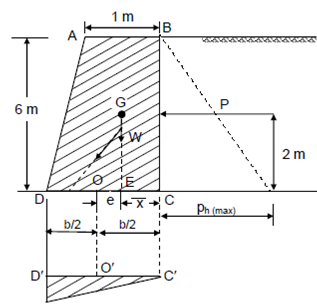Find out the value of the maximum pressure:
A masonry retaining wall of trapezoidal section retains level earth 6 metres high. The retaining wall is 1 m wide at the top, determine the bottom width so that no tension is induced in the base. The unit weight of masonry is 23 kN/m3 and of soil 15 kN/m3. The angle of repose of the soil is 30o and the back face of the wall is vertical.

Figure
Find out the value of the maximum pressure at the base.
Solution
A horizontal pressure ph at any depth h is given by
ph = w. h ⋅ 1 - sin φ/1 + sin φ 1= 15 × h 1-sin 30o/1 + sin 30o
ph = 15 ×1/3 h = 5 h (kN/m2 )
ph(max) = 5 × 6 = 30 kN/m2 (at h = 6 m) at base
Considering 1 m width of the wall.
Total horizontal pressure P = 30 × 6/2 = 90 kN acts at a height of 6/3 = 2 m from the bottom edge C.
If the width of a base of the wall for no tension is 'b' then weight of 1 m width of wall 23 × 1 × (1 + b/2 × 6 ) kN = 69 (1 + b) kN.
It acts by x¯ where x¯ is the distance of CG of this trapezium ABCD from line BC.